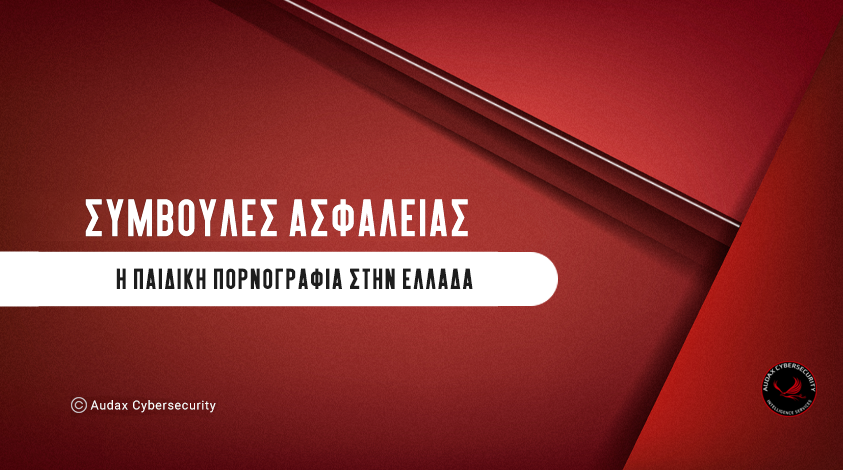Child pornography in Greece
In recent years there has been a rapid increase in the number of internet users downloading videos and photos of child pornography.
However, to date, the existence of an organised circuit filming acts of indecent exposure of minors has not been detected, but only in isolated cases.
How the "predators" work (Grooming= seduction of a minor)
Process in which "predators", pretending to be teenagers, use the open communication rooms (chat rooms), online communication sites to attract children with the intention of abusing them. The victims of grooming can suffer severe trauma that has a psychological and emotional impact, with very damaging effects on their health. The abuse suffered by a child involved in grooming, is not only sexual in nature, but also emotional, as children find it very difficult to cope with the demands and pressure of predators.
It should be noted that, during the period of adolescence, young people make their "personal revolution". This attitude of independence and the search for new acquaintances via the Internet make adolescents the most vulnerable group to the issue of child pornography and sexual harassment.
Often such websites are considered by children to be safe places to chat online, both because of the public nature of the discussion and because of children's misconception that their anonymity is being preserved. Predators initiate conversations with potential victims in order to develop a friendly relationship with them and to obtain as much information as possible about where they live, their interests, hobbies and sexual experiences.
Conversations can last for days, weeks, even months, until the predator gains the child's trust. Then they slowly provoke conversations of a sexual nature and send them pictures as something acceptable and normal. This tactic is intended to undermine the children's reluctance to take part in sexual intercourse, but also to prevent the victim from seeking help from parents and teachers, as they end up feeling guilty for having exchanged such photos.
Usually the "predators" are people above suspicion, who probably have their own family: peaceful, respectable, educated, prominent, financially well-off, e.g. scientists, teachers, businessmen, etc. They do not hesitate to exploit their position and also their relationship (relatives) to satisfy their sick passion.
Usually, "predators" have pedophilic tendencies. Pedophiles who cannot access underage children satisfy their needs and passions through the Internet, which gives them access to child pornography that satisfies their sexual needs.
How do the circuits work?
These are "closed groups", which communicate through discussion groups (new groups), via contact rooms (chat rooms) or by email (e-mails).
A common tactic used by material trafficking rings is the use of misleading photographs on the home page of websites. The websites on which they "upload" pornographic material of minors are "camouflaged" so that they cannot be detected (impossible with the use of a search engine). They create videos in which they mix adult pornography with underage pornography to make it difficult to track them.
Tips for children
- Check with your parents if you have had a problem with someone who may have approached you on the internet, through a website or app.
- If you have an account on a social networking site (after the age of thirteen), avoid putting your personal details (name, address, phone number, school) and photos of you or your classmates.
- If you want to put your photos on various pages, it is advisable that they do not show sensitive parts of your body or face and that they are taken from a distance.
- Use a complex password on your account, not one that can be guessed by someone . It's also a good idea for your parents to know your password, for security reasons.
-Do not accept friendship requests from strangers.
- Avoid entering pages where you are chatting with strangers or where the username or require the use of a camera.
- Never open your camera to strangers.
- If someone in a chat asks you to take a picture of your body or you in general and send it to them, do not do so under any circumstances and tell your parents immediately.
- Do not open messages/e-mail and especially,link,that are on them, even if they were sent by a friend of yours, since you don't know what page they lead to. For example, it may be that behind the link a virus is hiding.
- If an unknown user approaches you in a chat and talks to you in a naughty and sexually suggestive way, don't continue talking to them.
- If for any reason you feel unsafe or afraid, it is advisable to tell your parents or call 11188 for any help.
- The internet space offers a fictional reality. Therefore, it does not allow you to choose your friends with a complete view of who they are, as there is no direct contact with them, so be cautious about who you talk to and what you share with them.
It is important to remember that on the Internet you almost always don't know who you are talking to at that moment, whether you are turning on your computer or phone camera, whether they are recording you, or even how they will use or even where they will send a photo you have sent them.
Tips for parents
Regardless of how a person who intends to approach children may operate and violate the provisions of the above-mentioned articles, the following can be observed:
1. Children, sometimes, not taking into account the risks they may run, as they do not know the person they are talking to at the time, or thinking that they are talking to someone they know, when in fact it may be someone who may have hacked the profile of a friend/friend to approach children or someone who uses tricks in the written word to gain their trust, send their personal details (full names, addresses, phone numbers), upload (upload) or send (send) via the computer and the mobile phones (smartphones) photos of them, often with provocative content or even meeting with them.
Subsequently, these children may made at targets of cyberbullying (bulling), i.e. with threats and blackmail to ask them to send other photos with provocative content, not necessarily from the home page or from the application from which the any chat, but from any other website, application or service where he has them indicated to enter to carry out these actions.
Websites or applications where such actions can be observed are social media, but also online games with communication platforms (chat).
2. Children, wanting to spend their free time, to have fun, to solve their questions or even to follow the "fashion" of the time, for example by taking pictures of themselves (selfie) and others, carry out actions that essentially target and trap them. Actions such as the one mentioned above, as well as the opening of links (links) of unknown content, either from a website, an application or a service (e.g. e-mails) behind which may be another website or content unsuitable for children or even malware for the computer or phone, can lead to unexpected results for the child.
3. Given the above indicative and generalized examples:
- Achieving proper communication between parent-guardian and child is a primary factor, while in the case of any other absence or weakness, it is advisable to seek the advice of a specialist psychologist.
- Parents and guardians should be in control of the devices and storage media that children use to access websites, apps and services for any purpose. If parents and guardians do not have the necessary expertise, it is advisable to consider the advice of an expert.
- Parents and guardians are advised to know in advance the passwords to each of the profiles-accounts to which the child enters, in order to have full supervision.
- It is advisable that children of young age (under thirteen) do not have accounts on social media or, if it cannot be αποφευχθεί this, there must be proper communication and appropriate arrangements for third party access to them (e.g. search option, view only to friends, etc.).
- Avoid uploading (upload) or reference to some discussion of personal details, photos and even e-mail in the respective applications and services.
- Avoid the upload or sending photos with obscene content.
- In the case of an "upload" of a simple photograph with normal content, the children's faces must not be clearly visible in it or it must be taken at a distance, especially when the children are under thirteen.
- Not accepting unknown people as friends on any profiles or accounts that children may have.
- The friends the child has should only be the friends the child has in real life.
- Avoid logging into online chat pages or applications (chat) unfamiliar to children and where it is possible to talk to strangers, as well as those where a camera is used.
- Avoid opening a link (link) of unknown origin.
- We advise children to avoid using cameras, especially when talking to strangers or without the presence of parents and guardians.
It is important for parents not to forget that apart from the children, they must also protect themselves. They should not upload photos of their underage children, nor personal and Family their moments.
Cases establish the existence of a problem:
- Talking with the child about the full διερεύνηση of the problem, the source and exactly what has been done. We find out if there has only been a conversation or, in the case of a child has sent photos, what kind, how many and to whom, whether a camera has been used or encouraged and through which application.
- We consult a competent psychologist in case of inability to communicate properly with the child for any reason, and the subsequent management of the child's behaviour.
To collect evidence before any exclusion (block) or deleting the conversation (including the conversation and photos) with the unknown person or perpetrator, how to take them properly, how to locate them or what to do in general and for advice on the legal side of the problem, you can call 11188.
Child pornography material is disgusting and horrifying. Infants from a few months old to 17-year-olds are the tragic protagonists of these sick sexual videos and photographs, minors who, through the use of drugs, are forced into sexual intercourse with each other, with adults and even with animals.
Most of the photos and videos come from countries in Latin America, Southeast Asia and Africa, such as Venezuela, Brazil, Thailand, Singapore and Algeria.
Το κόστος απόκτησης των φωτογραφιών και των βίντεο από τα “αρπακτικά” κατηγοριοποιείται ανάλογα με την ηλικία των παιδιών ή το περιεχόμενο.
Source: Greek Police

